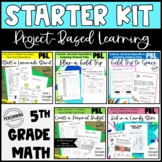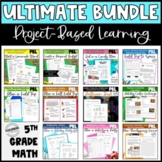Project Based Learning 5th Grade Math | Personal Budget | Decimals TEKS CCSS

What educators are saying
Also included in
- Project based learning bundle - 4th and 5th grade math PBLs. Practice fractions, decimals, graphing and more with these high-interest project-based learning activities!Looking for all 11 PBLs? Click here to buy the ultimate bundle and save even more!Aligned to 5th grade Common Core Standards, but alPrice $20.00Original Price $26.50Save $6.50
- This project-based learning bundle for 5th grade math integrates the standards + Mathematical Practices. These 11 projects will help you teach or review geometry, measurement, decimals, fractions, and much more!Save 30% by purchasing this bundle!Common Questions:Why do I need 11 projects?Each projecPrice $38.50Original Price $56.50Save $18.00
- This ultimate 5th grade Math bundle includes student reproducibles to use in Interactive Math Notebooks for 5th Grade ALL Common Core Math Standards and project-based learning activities (PBL) for the entire year. It's over 40% off! It's all in here ready for you to teach and your students to createPrice $45.00Original Price $82.50Save $37.50
Description
This is a student-favorite math project based learning (PBL) for 5th grade and financial literacy, which incorporates TEKS and Common Core standards. It can be used in the classroom or as distance learning. A print AND digital Google version is included! Help your students practice decimals and money skills with this quality project-based learning. Challenge activities allow for it to be used in 6th grade as well. It includes a teacher guide walking you through each step.
**THIS RESOURCE IS NOW ALSO ALIGNED TO TEKS FINANCIAL LITERACY STANDARDS FOR 5TH GRADE!**
Common Core Aligned to 5th grade - 5.NBT.B.6 and 5.NBT.B.7, but can be used for decimal operations practice at other grade levels!
Your kids will get their first peek at the process of creating a budget! Kids love having choices, and this project gives them the choices they want! Throughout this project, they get to choose their career, car, and house. Their choices may be limited depending on the salary they get with their career. During this fun activity, kids will practice percentages and decimal operations (multiplication, division, addition, and subtraction).
★ Find the 6th grade version of this project
This is a BEST SELLING Project-Based Learning activity! Teach your students real life math skills using this high-interest PBL, while applying the Common Core Standards they've learned! Your students will begin thinking about what career path they want to take, and will look at real life data on average salary, housing, food, and transportation costs. Supplementary articles on personal finance and functional text may be brought into this lesson to connect with Reading standards.
All of my PBLs include e-mail support. Check the feedback below to see what it's all about!
***************************************************************************
⇒ Bundles Available ⇐
★ ALL 5th Grade Project-Based Learning Activities (Discounted Bundle)
★ Grab an entire year’s worth of Math PBL & Interactive Math Notebooks (Discounted Bundle)
★ For homeschoolers and multi-grade teachers: Get unlimited access to EVERY GRADE LEVEL PBL and more features! (over 50% off!)
***************************************************************************
Customer Tips:
How to get TPT credit to use on future purchases:
• Please go to your My Purchases page after you log in. Beside each purchase see a Provide Feedback button. Simply click it and you will be taken to a page where you can give a quick rating and leave a short comment for the product. Each time you give feedback, TPT gives you feedback credits that you use to lower the cost of your future purchases. I value your feedback greatly as it helps me determine which products are most valuable for your classroom so I can create more for you.
Be the first to know about my new discounts, freebies and products:
• Look for the green star next to my store logo and click it to become a follower.
*****************************************************************************








